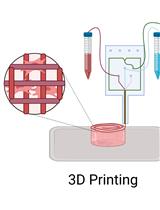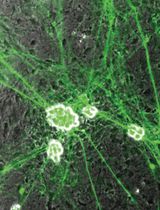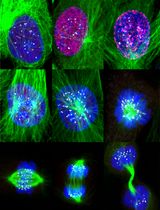- EN - English
- CN - 中文
A Novel Protocol to Generate Decellularized Bovine Spinal Cord Extracellular Matrix-based Scaffolds (3D-dCBS)
一种获得去细胞牛脊髓细胞外基质构成支架的新方法
发布: 2019年10月05日第9卷第19期 DOI: 10.21769/BioProtoc.3380 浏览次数: 4405
评审: Alessandro DidonnaSarah Daniela DiermeierAnonymous reviewer(s)

相关实验方案

使用基于纤维蛋白的生物墨水对间充质干细胞衍生的神经组织进行3D生物打印的方案
Milena Restan Perez [...] Stephanie Michelle Willerth
2023年05月05日 2304 阅读
Abstract
Extracellular matrix (ECM)-based tissue engineering scaffolds have an essential role in promoting tissue regeneration. Nerve tissue engineering aims at facilitating the repair of permanent damage to the peripheral and central nervous systems, which are difficult to heal. For this purpose, a variety of biomaterials are being developed consisting of numerous synthetic and/or natural polymers to provide axonal reinnervation and to direct the growth of axons. Here, we present a novel protocol that enables to fabricate a 3-dimensional (3D) decellularized scaffold derived from the bovine spinal cord (BSC) ECM (3D-dCBS) for neural tissue engineering applications. In this protocol, a viscous ECM-derived gel from BSC is prepared, molded, and chemically crosslinked with EDC/NHS (3D-CBS) before decellularization process. Decellularization of 3D-CBS is performed with 1% SDS to attain 3D-dCBS. As compared with other available methods, our protocol is a novel decellularization method that preserves a more significant part of the ECM. We believe that the mentioned protocol has the potential to produce a bioengineered scaffold from spinal cord tissue with desired geometry for regenerative medicine applications related to neural tissue engineering.
Keywords: Bovine spinal cord (牛脊髓)Background
Recently, nerve injuries have become a widespread issue that affects an approximate number of 20 million people in the United States alone and remain a significant burden on society (Du et al., 2018). According to data from the World Health Organization (2013), 250,000 to 500,000 people suffer a spinal cord injury due to traffic injuries, falls, and violence. When investigated the National Spinal Cord Injury Database, it is seen that spinal cord injury (SCI) caused by falls has dramatically increased. For instance, while that kind of injuries had occurred 17% in the 1970s, the value reached 31% during 2010-2013. In addition to this, the rate of fall-related SCI is indicated as 75% among persons 76 years of age and over (Chen et al., 2015). Following the SCI, mechanical stress and secondary injuries cause axonal degeneration. Following the SCI, mechanical stress and secondary injuries cause axonal degeneration. Although there are a few treatment approaches for axonal regeneration, it is still impossible to completely cure the damaged axons (Ban et al., 2017). Central nervous system (CNS) axons, unfortunately, have limited regeneration capacity after injury in contrast to axons of the peripheral nervous system (PNS). Therefore, the physiological response is considerably different in the repair of CNS and PNS. Because the macrophages assigned to repair of CNS injury cannot entry to the damaged zone due to blood-spine barrier, and thus tissue repair takes place slightly below of the desired level (Schmidt and Leach, 2003). Many strategies have been developed to provide axonal reinnervation and direct axonal growth, but recent approaches aim at preventing secondary injury, regeneration, and replacement of damaged spinal cord tissues.
Surgical operations and pharmacological methods have been preferred to minimize secondary damage, only treatment for SCI patients. However, there is currently no treatment available to repair nerve tissue function completely (Cristante et al., 2012; Varma et al., 2013; Schmidt and Leach, 2003). Cell-based regenerative therapy and tissue engineering strategies have a promising potential for recovering severe SCI (Assunção-Silva et al., 2015). More recently, neural tissue engineering has focused on natural or synthetic biopolymers that are combined to create a tissue engineering product (Boni et al., 2018). Natural and synthetic derived materials have some advantages and disadvantages, including mechanical, chemical, and biological features (O’ Brien, 2011). The most important properties of natural biopolymers such as gelatin, elastin, fibrinogen, silk, and collagen are a biocompatible, biodegradable and inherent structural similarity to mimic natural ECM. Despite these unique advantages, they have weak mechanical strength and inconsistency, which limit to develop ideal scaffolds for regenerative medicine applications (Haraguchi et al., 2012; Ulery et al., 2011; Sekula and Zuba‐Surma, 2018).
On the other hand, synthetic biopolymers such as poly (ε-caprolactone), poly (lactic acid) and their copolymers, poly (p-dioxanone), copolymers of trimethylene carbonate and glycolide are easily fabricated on a large scale by controlling their degradation rates (Gunatillake and Adhikari, 2003; Abbasian et al., 2019). However, various disadvantages such as toxic by-products resulting from biodegradation of the synthetic polymers restrict their applications in the field of tissue engineering (Tabata, 2009; Arslan et al., 2017). Due to limitations of synthetic and/or natural biopolymers and shortage of donors, acellular biologic scaffolds have become a new option for the treatment of missing or damaged tissues (Yu et al., 2016). Decellularization technique is a promising technology for tissue engineering and regenerative medicine applications because the technique aims at removing host cells from ultrastructure of native ECM by protecting unique ECM molecules (Kelleher and Vacanti, 2010). Many different methods including chemical, enzymatic, physical and/or their combinations, are used for the decellularization of native ECM. Preservation of structural integrity and mechanical properties of ECM in the decellularization process, which allows removing cellular components such as cells, cell debris, chromosome fragments, and xenogeneic antigens, is a crucial fact for achieving effective healing of the tissues (Crapo et al., 2011; Patnaik et al., 2014). Furthermore, acellular biologic scaffolds regulate the homeostasis and regeneration of tissues and organs by mimicking the ECM that acts as a niche for the cells (Tapias and Ott, 2014; Dzobo et al., 2018).
The ultimate goal of the proposed decellularization protocol is to effectively remove the nuclear contents (i.e., dsDNA) of native tissues and organs while maintaining the critical structural, biochemical, and biomechanical cues present in the ECM. This study has demonstrated a novel decellularization protocol, which enables an optimized strategy to fabricate a 3D bioscaffold for neural tissue engineering applications (Arslan et al., 2019). By using 1% sodium dodecyl sulfate (SDS), 50 mM Trizma® hydrochloride and 5 mM EDTA, we have executed the decellularization process at room temperature (RT) for 72 h. The results showed that the amounts of dsDNA in the native BSC and 3D-dCBS were found to be 520.76 ± 18.11 and 28.80 ± 0.20 ng/mg dry weight, respectively (n = 3; P < 0.001; ANOVA). The proposed method removed approximately 94.47% of nuclear material from the native BSC. It has been reported that the amount of dsDNA should be < 50 ng per mg dry weight and < 200 bp residual of the DNA fragment for the optimal decellularization (Pati et al., 2014).
Consequently, the main benefit of the presented method is constructing a 3D biomatrix from decellularized BSC with desired geometry. We believe that the recellularization of 3D-dCBS with neural stem and/or progenitor cells could have a positive effect on the supporting of deformed nerve tissue. In conclusion, we believe that the proposed approach to decellularization of BSC will open new horizons for the experts working in the field of neural tissue engineering.
Materials and Reagents
- 48-well Clear TC-treated Multiple Well Plates, Individually Wrapped, Sterile (Corning Incorporated, Costar®, catalog number: 3548)
- Falcon, 50 mI conical centrifuge tubes (Isolab, sterile, catalog number: 078.02.008)
- Falcon, 15 mI conical centrifuge tubes (Isolab, sterile, catalog number: 078.02.007)
- Borosilicate laboratory bottle, 250 mI, GL-45 (Interlab, catalog number: 061.01.250)
- Borosilicate laboratory bottle, 500 mI, GL-45 (Interlab, catalog number: 061.01.500)
- Metal pot, stainless steel, 250 mm diameter and 85 mm depth
- Scalpel, length 25 mm (Interlab, catalog number: 048.51.010)
- Scalpel blade holder, length 130 mm (Interlab, catalog number: 048.50.001)
- Glass petri dish, diameter 60 mm; height 15 mm (Interlab, catalog number: 081.01.060)
- Parafilm M (Sigma-Aldrich, catalog number: P7543)
- Magnetic stirring bar; length 10 mm; diameter 6 mm (Interlab, catalog number: 057.01.010)
- FinnpipetteTM F2 Fixed Volume Single-Channel Pipettes; 100 to 1,000 μl (Thermo-Scientific, catalog number: 4642090)
- FinnpipetteTM F2 Fixed Volume Single-Channel Pipettes; 10 to 100 μl (Thermo-Scientific, catalog number: 4642070)
- Glass Erlenmeyer flask; volume 50 mI (Interlab, catalog number: 027.01.050)
- Erlenmeyer flask cap, NS 12/21 (Interlab, catalog number: 051.08.012)
- Screwcap GL-45, blue (Interlab, catalog number: 051.09.45B)
- Laboratory forceps, length 115 mm, 304 stainless steel (Interlab, catalog number: 048.08.115)
- Spoon spatula, length 150 mm, 304 stainless steel (Interlab, catalog number: 047.01.150)
- Borosilicate graduated cylinder, 250 mI (Interlab, catalog number: 015.01.250)
- Borosilicate graduated cylinder, 500 mI (Interlab, catalog number: 015.01.500)
- μDropTM Plate (Thermo-Scientific, MultiskanTM with mdropTM plate)
- BSC, the bovine spinal cord (BSC) from Holstein-Friesian cattle [thoracic region (T2–T11)] was obtained within 4-6 h following the slaughtering of healthy animals (16-month-old) at a local slaughterhouse in Balikesir, Turkey
- Ethylenediaminetetraacetic acid disodium salt dihydrate (EDTA-Na2) (Sigma-Aldrich, catalog number: E5134)
- Trizma® hydrochloride (Sigma-Aldrich, catalog number: T5941)
- Sodium dodecyl sulfate (SDS) (Sigma-Aldrich, catalog number: L4509)
- Peracetic acid solution (Sigma-Aldrich, catalog number: 433241)
- Ethanol 99% (Sigma-Aldrich, catalog number: 32221)
- Magnesium chloride (Sigma-Aldrich, catalog number: M8266)
- Deoxyribonuclease I from bovine pancreas, DNase I (Sigma-Aldrich, catalog number: DN25)
- Ribonuclease A from bovine pancreas, RNase A (Sigma-Aldrich, catalog number: R5503)
- Sodium hydroxide (Sigma-Aldrich, catalog number: 06203)
- Hydrochloric acid (Sigma-Aldrich, catalog number: 07102)
- 2-(N-Morpholino) ethanesulfonic acid (MES) (Sigma-Aldrich, catalog number: M3885)
- N-Hydroxysuccinimide (NHS) (Sigma-Aldrich, catalog number: 8.04518)
- N-(3-Dimethylaminopropyl)-N′-ethylcarbodiimide hydrochloride (EDC) (Sigma-Aldrich, catalog number: 8.00907)
- Milli-Q water (Merck-Millipore, Type I-III, catalog number: ZRQSVP3WW)
- 0.1 N NaOH solution (see Recipes)
- 1 M NaOH solution (see Recipes)
- 1 M HCl solution (see Recipes)
- 70% ethanol solution (see Recipes)
- 0.05 M 2-(N-Morpholino) ethanesulfonic acid (MES) buffer (pH 5.5) (see Recipes)
- Crosslinking (EDC/NHS) solution (see Recipes)
- Hypertonic solution (see Recipes)
- RNase A and DNase I enzyme solutions (see Recipes)
- Decontamination solution (4% ethanol/0.1% peracetic acid) (see Recipes)
Equipment
- Ultrasonic bath (Elma, Elmasonic S30H)
- Lyophilizer -55 °C (Telstar, LyoQuest)
- Milli-Q® Integral water purification system for ultrapure water (Merck-Millipore, Type I, Direct-Q® 3 UV)
- Freeze dryer (Telstar, LyoQuest -55)
- Vortex (IKA Genious 4, V4B)
- Analytical balance (Shimadzu, model: ATX224)
- pH Meter (Mettler Toledo, model: FiveEasyTMFE20)
- Magnetic stirrer (Multi Position) (Jeiotech, MS-12BB, catalog number: AAH330115BK)
- Mechanical homogenizer (IKA, T18 Basic Ultra TURRAX)
- Automatic single-channel pipettes, 10-100 and 100-1,000 µl (Gilson-compatible, Diamond® Eco-PackTM)
- Refrigerator (Siemens, model: KG57NPW24N)
- Ultra-low temperature freezer (Panasonic, model: MDF-U5386S-PE)
- Orbital shaker incubator-temperature controlled (Benchmark, model: Incu-ShakerTM Mini)
Procedure
文章信息
版权信息
© 2019 The Authors; exclusive licensee Bio-protocol LLC.
如何引用
Arslan, Y. E., Efe, B. and Sezgin Arslan, T. (2019). A Novel Protocol to Generate Decellularized Bovine Spinal Cord Extracellular Matrix-based Scaffolds (3D-dCBS). Bio-protocol 9(19): e3380. DOI: 10.21769/BioProtoc.3380.
分类
细胞生物学 > 细胞活力 > 细胞增殖
细胞生物学 > 细胞工程 > 组织工程
您对这篇实验方法有问题吗?
在此处发布您的问题,我们将邀请本文作者来回答。同时,我们会将您的问题发布到Bio-protocol Exchange,以便寻求社区成员的帮助。
提问指南
+ 问题描述
写下详细的问题描述,包括所有有助于他人回答您问题的信息(例如实验过程、条件和相关图像等)。
Share
Bluesky
X
Copy link













